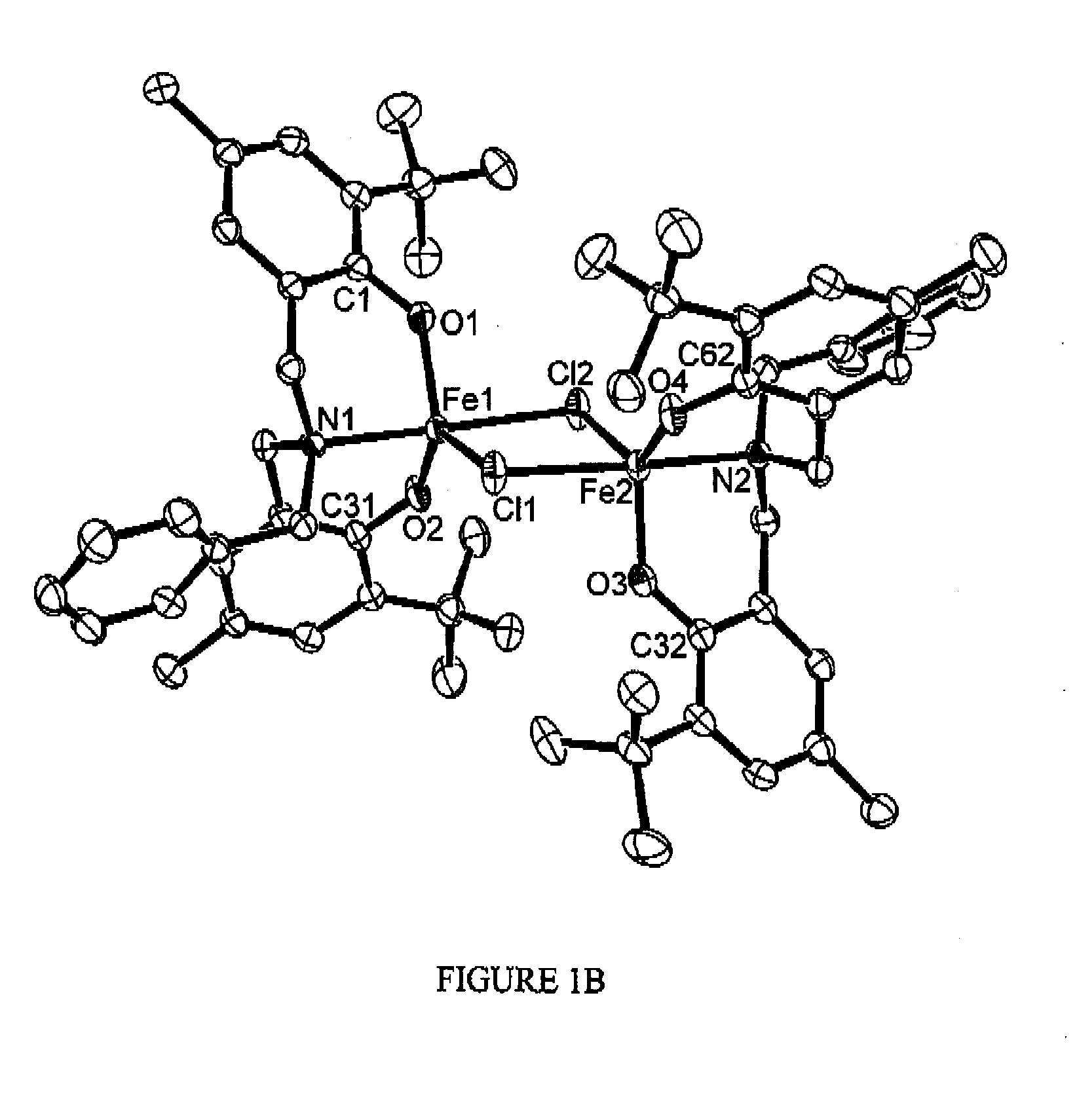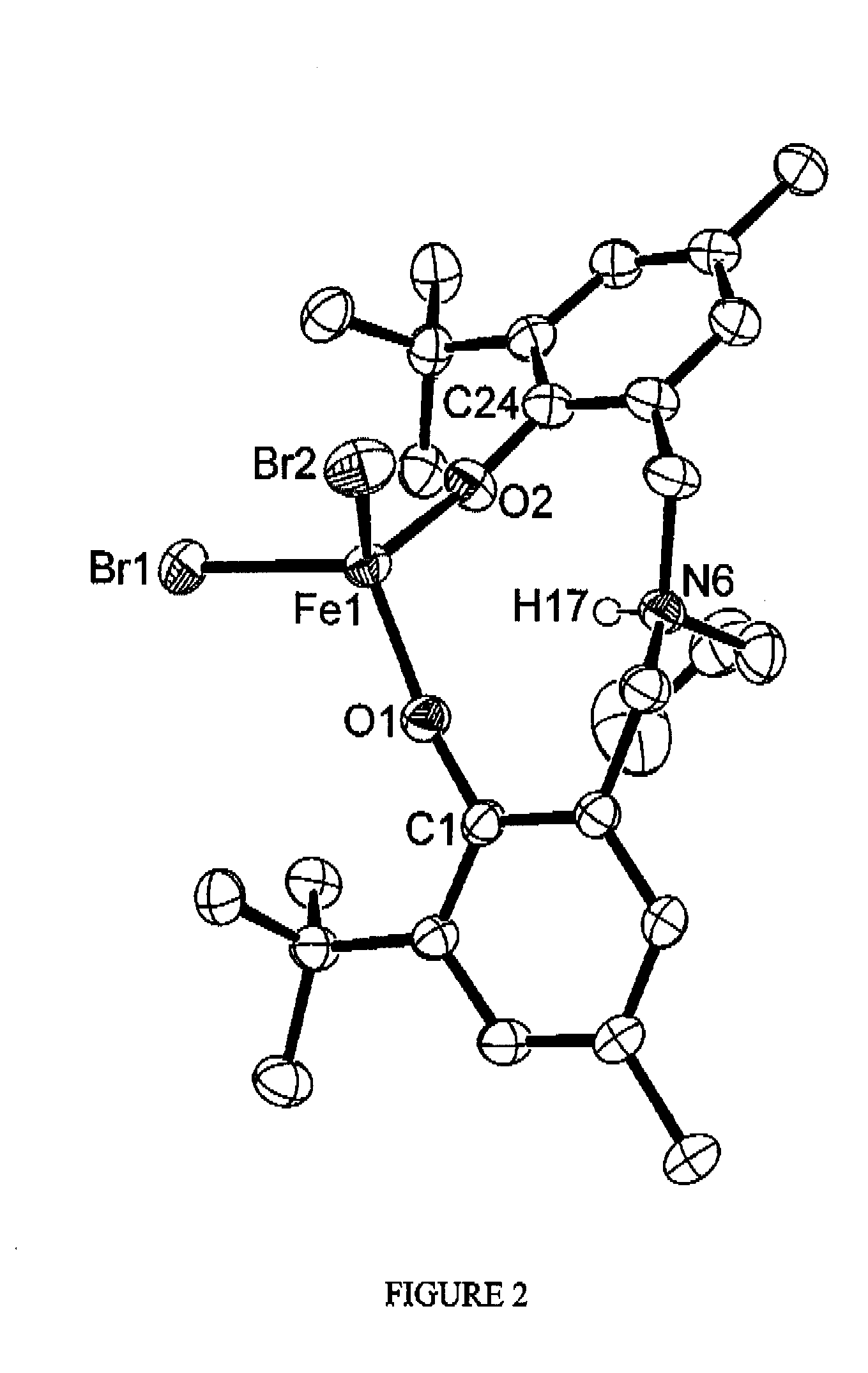Iron bisphenolate complexes and methods of use and synthesis thereof
a technology of iron bisphenolate and complexes, which is applied in the direction of iron organic compounds, catalytic reactions, chemical/physical processes, etc., can solve the problems of high cost, potential toxicity of residual catalysts in products, and use of metal catalysts
- Summary
- Abstract
- Description
- Claims
- Application Information
AI Technical Summary
Benefits of technology
Problems solved by technology
Method used
Image
Examples
example 1
Preparation and characterization of Tridentate Ligands and Complexes
[0166]Synthesis of Iron Complex {FeCl[O2N]tBuMePr}2
[0167]Synthesis of Ligand:
[0168]To a stirred mixture of 2-t-butyl-4-methylphenol (20,236 g, 0.1232 mol) in 75 mL deionized water was added 37% aqueous formaldehyde (10 mL, 0.1232 mol) followed by slow addition of n-propyl amine (3.64 g, 0.0615 mol). The reaction was heated to reflux for 12 h. Upon cooling, the reaction mixture separated into two phases. The upper phase was decanted and the remaining oily residue was triturated with cold methanol to give an analytically pure, white powder (23.01 g, 91%). Anal. Calcd for C27H41NO2: C, 78.78; H, 10.04; N, 3.40. Found C, 78.85; H, 10.14; N, 3.32. 1H NMR (500 MHz, CDCl3, δ): 7.00 (d, J=1.6 Hz, ArH, 2H); 6.73 (d, J=1.6 Hz, ArH, 2H); 3.63 (s, CH2, 4H); 2.48 (t, J=7.5 Hz, CH2, 2H); 2.24 (s, CH3, 6H); 1.62 (m, CH2, 2H); 1.39 (s, CH3, 18H); 0.86 (t, J=7.5 Hz, CH3, 3H). 13C{1H}NMR (125 MHz, 298 K, CDCl3): δ 152.7 (Ar); 137.0 ...
example 2
Preparation and Characterization of Tetradentate Ligands and Complexes
[0194]All manipulations and handling of ligands and iron complexes were performed in air. Reagents were purchased and used without further purification. The amine-bis(phenolate)-ether ligands, H2[L1] to H2[L5], (shown in Scheme 4 below) were prepared by modified literature procedures (e.g. as found in Kerton et al. 2008 Can. J. Chem. Vol. 86, p. 435) employing Mannich condensation of 2,4-dichlorophenol or 2,4-difluorophenol, formaldehyde and the corresponding primary amine in water, as described below.
[0195]To a mixture of 2,4-dichlorophenol (20.06 g, 0.123 mol) and 37% aqueous formaldehyde (10.00 mL, 0.123 mol) in water (50 mL) was slowly added aminomethylpyridine (6.60 g, 0.061 mol), which resulted in a cloudy suspension. The mixture was stirred and heated to reflux for 12 b. Upon cooling, a large quantity of pale orange solid formed. The solvents were decanted and the remaining solid residue was washed with col...
example 3
Cross-Coupling Catalysis with Tridentate amine-bis(phenolate) Iron Complexes
[0232]The catalytic ability of tridentate iron amine (bisphenolate) complexes was demonstrated using the complex {FeCl[O2N]tBuMePr}2. The air-stable, single component iron(III) complex {FeCl[O2N]tBuMePr}2 catalyzes the C(sp3)-C(sp2) bond forming reaction between aryl Grignard reagents and alkyl halides, including primary as well as cyclic or acyclic secondary alkyl chlorides. The synthesis and characterization of the tridentate amine (bisphenolate) iron complex employed in the cross coupling reactions as follows are described in Example 1.
[0233]The cross coupling reaction was performed according to the general scheme:
R4—MgBr+R5—Br→R4—R5
[0234]Unless otherwise stated, all manipulations were performed under an atmosphere of dry oxygen-free nitrogen by means of Schlenk techniques or using an MBraun LabmasterDP glove box. Anhydrous diethyl ether was purified using an MBraun Solvent Purification System. THF was s...
PUM
| Property | Measurement | Unit |
|---|---|---|
| structure | aaaaa | aaaaa |
| electronegative | aaaaa | aaaaa |
| temperature | aaaaa | aaaaa |
Abstract
Description
Claims
Application Information
 Login to View More
Login to View More - R&D
- Intellectual Property
- Life Sciences
- Materials
- Tech Scout
- Unparalleled Data Quality
- Higher Quality Content
- 60% Fewer Hallucinations
Browse by: Latest US Patents, China's latest patents, Technical Efficacy Thesaurus, Application Domain, Technology Topic, Popular Technical Reports.
© 2025 PatSnap. All rights reserved.Legal|Privacy policy|Modern Slavery Act Transparency Statement|Sitemap|About US| Contact US: help@patsnap.com



